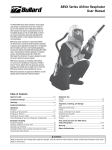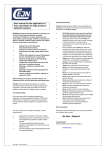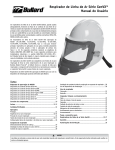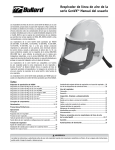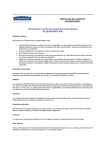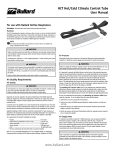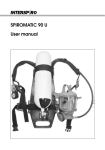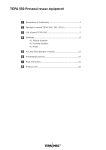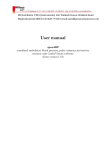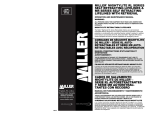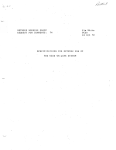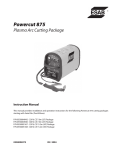Transcript
Proper Use and Care of Your Bullard Airline Respirator � WARNING 1.This respirator, when properly fitted and used, in conjunction with adherence to OSHA regulations and industry standards, will provide a reasonable degree of protection to the wearer. The respirator significantly reduces, but may not totally eliminate, the breathing of contaminants depending on the work practices involved. Where concentrations of contaminants are excessive, respirator wearers may obtain a higher level of protection from a valve-operated, pressure demand airline respirator or a pressure demand, self contained breathing apparatus (SCBA) respirator. At this time there are no side by side field studies for comparison. However, OSHA does assign higher protection factors to these groups of respirators. Ideally, the employer should measure concentrations inside the breathing zone on a periodic basis to ensure that the wearer is receiving adequate protection. 2.Before using this respirator, Federal Law requires that the employer shall identify and evaluate the respiratory hazard(s) in the workplace, and that this evaluation shall include a reasonable estimate of employee exposures to respiratory hazard(s) and an identification of the contaminant’s chemical state and physical form. Do not exceed maximum use concentrations established by OSHA, EPA, NIOSH, ACGIH, or other regulatory standards. 3.Improper respirator use may damage your health and/or cause your death. Improper use may also cause certain life threatening delayed lung diseases such as silicosis, pneumoconiosis, or asbestosis. 4.DO NOT wear this respirator if any of the following conditions exist: - Atmosphere is immediately dangerous to your life or health (IDLH), - You CANNOT escape without the aid of the respirator, - Atmosphere contains less than 19.5% oxygen, - Work area is poorly ventilated, - Unknown contaminants are present, or - C ontaminant concentrations are in excess of regulations or recommendations (as described in item 2 above). 5.DO NOT wear this respirator until you have passed a complete medical evaluation (perhaps including a lung x-ray) conducted by qualified medical personnel, and have been trained in the respirator’s use, maintenance, and limitations by a qualified individual (appointed by your employer) who has extensive knowledge of Bullard 88VX and/or GenVX Series respirators. 6.DO NOT modify or alter this respirator in any manner. Use only NIOSH approved 88VX or GenVX Series components and replacement parts manufactured by Bullard for use with this respirator. Failure to use NIOSH-approved Bullard components and replacement parts such as lenses, hoses, flow control devices, capes, and climate control devices, voids NIOSH approval of the entire respirator, invalidates all Bullard warranties, and could cause death, serious injury, lung disease, or exposure to other hazardous or life threatening conditions. 7.Inspect all components of this respirator system daily for signs of wear, tear, or damage that might reduce the degree of protection originally provided. Immediately replace worn or damaged components with NIOSH approved Bullard 88VX or GenVX Series components or remove the respirator from service. (See INSPECTION, CLEANING, AND STORAGE section of User Manual for proper maintenance of 88VX or GenVX Series respirators.) 8.Be certain your employer has determined that the breathing air source provides at least Grade D breathable air. This respirator must be supplied with clean breathable air at all times. 9.Do not connect the respirator’s air supply hose to nitrogen, oxygen, toxic gases, inert gases, or other unbreathable, non-Grade D air sources. To prevent this, airline couplings used for this respirator shall be incompatible with outlets for other gas systems. Check the air source before using the respirator. Failure to connect to the proper air source could result in death or serious injury. 10.Do not use this respirator in poorly ventilated areas or confined spaces such as tanks, small rooms, tunnels, or vessels unless the confined space is well ventilated and the contaminant concentrations are below the upper limit recommended for this respirator. In addition, follow all procedures for confined space entry, operation and exit as defined in applicable regulations and standards, including 29 CFR 1910.146. 11.If you have any questions concerning the use of this respirator, or if you are not sure whether the atmosphere you are working in is immediately dangerous to life or health (IDLH), ask your employer. All instructions for the use and care of this product must be supplied to you by your employer as recommended by the manufacturer and as required by Federal Law (29 CFR 1910.134). 12.Do not use this respirator for underwater diving. 13. Leave work area immediately if: -Any respirator component becomes damaged. -Airflow into respirator stops or slows down. -Air pressure gauge drops below the minimum specified in the Breathing Air Pressure Table in the 88VX or GenVX Series User Manual. -Breathing becomes difficult. -You become dizzy, nauseous, too hot, too cold, or ill. -You taste, smell, or see contaminants inside the respirator hood. -Your vision becomes impaired. 14. Historically, the incidence of disease from overexposure to toxic substances almost always occurs because the OSHA regulations and industry standards applicable to the work practices involved are not followed. It is, therefore, imperative that the employer acquaint itself with and follow all of these standards and regulations. REMEMBER: -Respiratory protections is but one component of safe work practices. To minimize the chances of overexposure, all safety regulations and standards must be followed; and -Respiratory protection is the last line of defense to be employed. The employer must first eliminate or minimize the levels of toxic substances in the work place by accepted engineering control measures. Assuming the employer and the wearer do their part, this respirator should provide the wearer with an adequate degree of protection. Prior to respirator use, be certain of the following: Air Supply Air Quality: Respirable, breathing air must be supplied to the point-of-attachment of the approved Bullard air supply hose. The point-of-attachment is the point at which the air supply hose connects to the air source. A pressure gauge attached to the air source is used to monitor the pressure of air provided to the respirator wearer. � WARNING This respirator MUST be supplied with clean, breathable air, Grade D or better, at all times. This respirator does NOT purify air or filter out contaminants. Failure to follow these instructions could result in death or serious injury. Air Source: Locate the source of supplied air whether it is an air compressor or an ambient air pump, such as a Bullard Free-Air Pump, in a clean air environment. Locate the air source far enough from your work site to ensure the air remains contaminant-free. Always use an inlet filter on your air source. Use suitable after-cooler/dryers, filters, carbon monoxide monitors and alarms, like the Bullard CO monitor, as necessary to assure clean, breathable air at all times. The air should be regularly sampled to be sure that it meets Grade D requirements. Breathing Air Pressure: Air pressure must be continually monitored at the point-of-attachment while operating this respirator. A reliable air pressure gauge must be present to permit you to continually monitor the pressure during actual respirator operation. � WARNING Failure to supply the minimum required pressure at the point-of-attachment for your hose length and type will reduce airflow could result in death or serious injury. Breathing Air Pressure Table These tables define the air pressure ranges necessary to provide the 88VX with a volume of air that falls within the required range of 6-15 or 170-425 lpm according to U.S. Government Regulations (42 CFR, Subpart J, 84.150, Table 8). First, find the table with the correct flow control device, then find the air supply hose length, the value within the corresponding box represents the proper operating air pressure. F30, F30B, F30S F31 F30 Series Constant Flow Pressure Table (pressures in psi) 3 V10 Air Supply Hose Lengths Nipple Type 25’ (1*) 50’ (2*) 100’ (3*) 150’ (4*) Industrial Interchange 14-15 15-18 19-24 23-29 Schrader 14-15 15-18 19-24 23-29 F32 Snap Tite 14-15 15-18 19-24 F33 F34 F37 F38 Snap Tite Brass Snap Tite Stainless CEJN Bayonet 14-15 14-15 14-15 14-15 15-18 15-18 15-18 15-18 19-24 19-24 19-24 19-24 1 Flow Control Device 1 Flow Control Device AC100030 (S) (B) AC100031 NIOSH Approved Bullard Air Supply Hose(s) NIOSH approved Bullard air supply hose(s) MUST be used between the breathing tube connection fitting on the wearer’s belt and the point-of-attachment to the air supply. NIOSH Approved Bullard Fittings NIOSH approved Bullard quick-disconnect fittings MUST be used to connect V5 or V20 hose lengths together. When connecting lengths of V10 hose, only use Bullard V11 hose-to-hose adapters. Secure connection(s) until wrenchtight and leakfree. Total connected hose length and number of hoses MUST be within the ranges specified on the Breathing Air Pressure Table (in the 88VX or GenVX Series User Manuals) and the respirator’s NIOSH approval label (in the 88VX or GenVX Series User Manuals). The Breathing Tube Assembly must be attached to the belt supplied with this respirator. Securing the breathing tube assembly to your belt helps prevent the air supply hose from snagging, disconnecting, or pulling the helmet off your head. worn for general purpose applications, including heavy and light-duty abrasive blasting, and spray painting. This respirator is not approved for use in any atmosphere immediately dangerous to life or health (IDLH), or from which the wearer cannot escape without the aid of the respirator. Head – 88VX and GenVX Series respirators meet ANSI/ISEA Standard Z89.1-2010 Type 1 Class C requirements for protective headwear for industrial workers. The helmet is designed to provide limited head protection by reducing the force of falling objects striking the top of the helmet. Eyes – � CAUTION protection. The use of both windows provide limited face protection from flying particles or spray of hazardous liquids, but is not shatterproof. There is no need to apply Anti-Fog to these lenses. Ears – 88VX and GenVX Series respirators DO NOT provide hearing protection. Use properly fitted earmuffs, earplugs or other protection when exposed to high noise levels. Use and Care: Carefully read the 88VX or GenVX User Manual supplied with the original factory packaging. If you do not have a copy, contact your employer or Bullard. •Remove dust and, if possible, vacuum the cape so that it is contaminant-free before leaving the work area and removing respirator. •Putting on or removing respirator MUST NOT take place in a hazardous atmosphere, except for emergency escape purposes. •Inspect all components of this respirator system daily for signs of wear, tear, or damage that might reduce the degree of protection originally provided. •Immediately replace any worn or damaged components with NIOSH approved Bullard respirator components. EC Type Examination to PPE 89/686/EEC Article 10 by SGS Yarsley ICS LTD, East Grinstead, West Sussex, RH194ET (88E ONLY) (No 0120) Date of Manufacture: Replacement Cape Part No: 23-29 25-34 31-39 23-29 23-29 23-29 23-29 25-34 25-34 25-34 25-34 31-39 31-39 31-39 31-39 AC1000 Series Cool Tube Pressure Table (pressures in psi) 3 V10 Air Supply Hose Lengths Nipple Type 25'-50' (2*) 75'-150' (3) Industrial Interchange 55-65 60-70 Schrader 55-65 60-70 2 175'-300' 65-75 65-75 Snap Tite 55-65 60-70 65-75 Snap Tite Brass Snap Tite Stainless CEJN Bayonet 55-65 55-65 55-65 55-65 60-70 60-70 60-70 60-70 65-75 65-75 65-75 65-75 DC5040 (S) (B) DC5041 DC50 Series Dual Cool Tube Pressure Table (pressures in psi) 3 V10 Air Supply Hose Lengths Nipple Type 50' (2*) 100' (3*) 150' (3*) 200' (3*) Industrial Interchange 48-52 59-63 68-72 80-84 Schrader 48-52 59-63 68-72 80-84 DC5042 Snap Tite 48-52 59-63 68-72 80-84 85-92 90-98 DC5043 DC5044 DC5047 DC5048 Snap Tite Brass Snap Tite Stainless CEJN Bayonet 48-52 48-52 48-52 48-52 59-63 59-63 59-63 59-63 68-72 68-72 68-72 68-72 80-84 80-84 80-84 80-84 85-92 85-92 85-92 85-92 90-98 90-98 90-98 90-98 1 Flow Control Device 2 250' (3*) 85-92 85-92 CT30, CT30B, CT30S CT30SW (Swivel) CT Series Cool Tube Pressure Table (pressures in psi) 3 V10 Air Supply Hose Lengths Nipple Type 25' (1*) 50' (2*) 75' (2*) 100' (3*) 150' (3*) 200' (4*) Industrial Interchange 54-56 57-58 59-61 60-64 68-71 71-75 Industrial Interchange 57-59 61-62 67-67 64-68 71-75 72-79 CT31 Schrader 50-51 53-55 55-58 57-61 64-68 CT32 CT33 CT34 CT37 CT38 Snap Tite Snap Tite Brass Snap Tite Stainless CEJN Bayonet 49-50 49-50 49-50 44-44 54-57 53-53 53-53 53-53 49-49 58-60 55-56 55-56 55-56 53-53 61-63 57-59 57-59 57-59 53-56 61-67 63-68 63-68 63-68 59-63 67-73 1 Flow Control Device 300' (5*) 90-98 90-98 2 250' (4*) 74-78 76-83 300' (5*) 80-85 78-87 65-72 71-78 74-82 67-71 67-71 67-71 63-68 70-77 71-78 71-78 71-78 67-75 75-82 75-81 75-81 75-81 70-79 77-85 250' (4*) 78-84 84-90 300' (5*) 82-88 87-98 HCT30 (S) (B) HCT30SW (Swivel) HCT Series Hot/Cold Tube (Hot Air to Hood) Pressure Table (pressures in psi) 2 3 V10 Air Supply Hose Lengths Nipple Type 25' (1*) 50' (2*) 75' (2*) 100' (3*) 150' (3*) 200' (4*) Industrial Interchange 53-65 56-60 59-66 62-68 69-74 73-79 Industrial Interchange 62-75 62-77 67-80 70-75 76-87 78-90 HCT31 Schrader 53-67 56-60 59-65 62-67 68-75 72-85 78-90 81-88 HCT32 HCT33 HCT34 HCT37 HCT38 Snap Tite Snap Tite Brass Snap Tite Stainless CEJN Bayonet 51-64 51-64 51-64 46-60 57-71 54-67 54-67 54-67 50-51 61-74 57-70 57-70 57-70 53-67 64-77 60-72 60-72 60-72 56-68 68-78 68-78 68-78 68-78 64-77 73-85 71-82 71-82 71-82 68-80 76-88 77-88 77-88 77-88 74-85 82-94 80-92 80-92 80-92 77-89 85-97 250' (4*) 87-89 92-97 300' (5*) 91-95 98-100 1 Flow Control Device HCT30 (S) (B) HCT30SW (Swivel) HCT Series Hot/Cold Tube (Cold Air To Hood) Pressure Table (pressures in psi) 2 3 V10 Air Supply Hose Lengths Nipple Type 25' (1*) 50' (2*) 75' (2*) 100' (3*) 150' (3*) 200' (4*) Industrial Interchange 61-62 65-66 68-69 71-72 77-80 81-82 Industrial Interchange 72-73 74-77 80-80 77-84 89-90 90-92 HCT31 Schrader 65-67 66-67 72-73 72-78 79-86 85-90 90-96 91-97 HCT32 HCT33 HCT34 HCT37 HCT38 Snap Tite Snap Tite Brass Snap Tite Stainless CEJN Bayonet 61-63 61-63 61-63 57-58 68-69 66-67 66-67 66-67 60-61 72-73 68-69 68-69 68-69 65-65 76-76 71-72 71-72 71-72 67-69 77-80 78-80 78-80 78-80 74-75 84-87 82-84 82-84 82-84 78-80 87-91 87-91 87-91 87-91 84-86 93-97 91-95 91-95 91-95 88-90 96-100 1 Flow Control Device F40, F40B, F40S F41 F40 Series Adjustable Flow Pressure Table (pressures in psi) 3 V10 Air Supply Hose Lengths Nipple Type 25' (1*) 50' (2*) 100' (3*) 150' (4*) 200' (5*) Industrial Interchange 22-25 24-27 27-32 30-37 33-40 Schrader 22-25 24-27 27-32 30-37 33-40 F42 Snap Tite 22-25 24-27 27-32 30-37 33-40 38-45 F43 F44 F47 F48 Snap Tite Brass Snap Tite Stainless CEJN Bayonet 22-25 22-25 22-25 22-25 24-27 24-27 24-27 24-27 27-32 27-32 27-32 27-32 30-37 30-37 30-37 30-37 33-40 33-40 33-40 33-40 38-45 38-45 38-45 38-45 1 Flow Control Device 1 Flow Control Device HC240030 (B) (S) HC240031 2 250'-300' (5*) 38-45 38-45 HC2400 Series Hot/Cold Tube Pressure Table (pressures in psi) 3 V10 Air Supply Hose Lengths Nipple Type 25' (1*) 50' (2*) 100' (3*) 150' (4*) 200' (4*) Industrial Interchange 61-63 63-65 68-70 73-75 77-79 Schrader 61-63 63-65 68-70 73-75 77-79 2 250' (5*) 80-82 80-82 300' (5*) 84-86 84-86 HC240032 Snap Tite 61-63 63-65 68-70 73-75 77-79 80-82 84-86 HC240033 HC240034 HC240037 HC240038 Snap Tite Brass Snap Tite Stainless CEJN Bayonet 61-63 61-63 61-63 61-63 63-65 63-65 63-65 63-65 68-70 68-70 68-70 68-70 73-75 73-75 73-75 73-75 77-79 77-79 77-79 77-79 80-82 80-82 80-82 80-82 84-86 84-86 84-86 84-86 88VX and GenVX respirators DO NOT provide eye protection. Wear approved safety glasses or goggles at all times. Failure to follow these instructions may result in minor or moderate injury. Face – The tandem use of the respirator’s inner and outer windows meet ANSI Z87.1-2003 (High impact plus Z87 + Face Protection) requirements for face 250' -300' (5*) 31-39 31-39 AC100033 AC100034 AC100037 AC100038 Protection Respiratory – The 88VX Series respirator is NIOSH approved and GenVX Series respirator is NIOSH approved as a Type C and CE respirator. It can be 200’ (5*) 25-34 25-34 AC100032 The Breathing Air Pressure Table The Breathing Air Pressure Table (in either the 88VX or GenVX Series User Manual) defines the air pressure ranges necessary to provide 88VX or GenVX Series respirators with a volume of air that falls within the required range of 6-15 cfm or 170-425 lpm (Ref. 42 CFR, Part 84, Subpart J, Table 8). 2 FRIGITRON2000 FRIGITRON2000B Frigitron Free Air Pump Cool Tube and F35 Constant Flow Pressure Table (pressures in psi) 2 3 V20 Air Supply Hose Lengths Nipple Type 50' (1*) 100' (2*) 200' (2*) Industrial Interchange 16-22 18-25 22-30 Industrial Interchange 16-22 18-25 22-30 FRIGITRON2000S Industrial Interchange 16-22 18-25 22-30 25-34 F35 F35B F35S Industrial Interchange Industrial Interchange Industrial Interchange 4-6 4-6 4-6 6-8 6-8 6-8 10-15 10-15 10-15 13-18 13-18 13-18 1 Flow Control Device 300' (3*) 25-34 25-34 * Indicates the maximum number of hose sections allowed. NOTE: IF USING THE GENVX RESPIRATOR REFERENCE THE BREATHING AIR PRESSURE TABLE LOCATED INSIDE THE GENVX USER MANUAL. NIOSH approved Bullard 88VX Series respirator components including cape, hose(s) and helmet (NIOSH Approval No. TC-19C-293). Americas: Bullard 1898 Safety Way Cynthiana, KY 41031-9303 • USA Toll-free within USA: 877-BULLARD (285-5273) Tel: +1-859-234-6616 Fax: +1-859-234-8987 Europe: Bullard GmbH Lilienthalstrasse 12 53424 Remagen • Germany Tel: +49-2642 999980 Fax: +49-2642 9999829 ww w.bullard.c om Asia-Pacific: Bullard Asia Pacific Pte. Ltd. LHK Building 701, Sims Drive, #04-03 Singapore 387383 Tel: +65-6745-0556 Fax: +65-6745-5176 60808810573A (0513)
